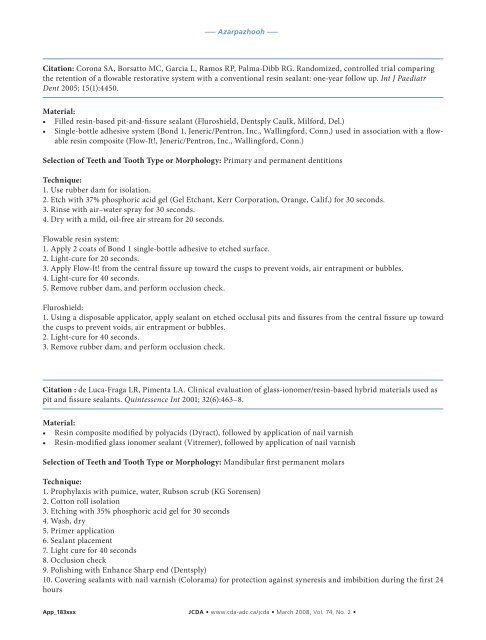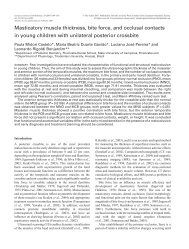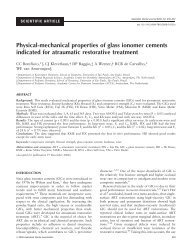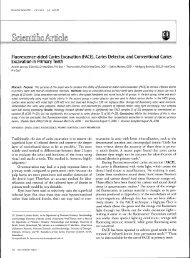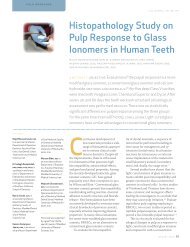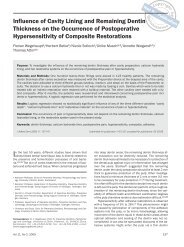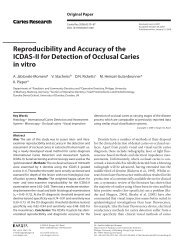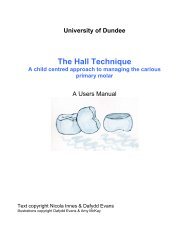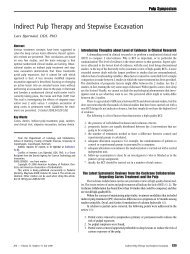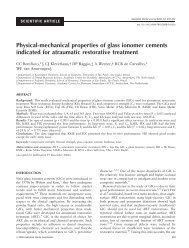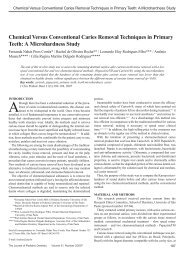Pit and Fissure Sealants in the Prevention of Dental Caries in ...
Pit and Fissure Sealants in the Prevention of Dental Caries in ...
Pit and Fissure Sealants in the Prevention of Dental Caries in ...
You also want an ePaper? Increase the reach of your titles
YUMPU automatically turns print PDFs into web optimized ePapers that Google loves.
––– Azarpazhooh –––<br />
Citation: Corona SA, Borsatto MC, Garcia L, Ramos RP, Palma-Dibb RG. R<strong>and</strong>omized, controlled trial compar<strong>in</strong>g<br />
<strong>the</strong> retention <strong>of</strong> a flowable restorative system with a conventional res<strong>in</strong> sealant: one-year follow up. Int J Paediatr<br />
Dent 2005; 15(1):4450.<br />
Material:<br />
• Filled res<strong>in</strong>-based pit-<strong>and</strong>-fissure sealant (Fluroshield, Dentsply Caulk, Milford, Del.)<br />
• S<strong>in</strong>gle-bottle adhesive system (Bond 1, Jeneric/Pentron, Inc., Wall<strong>in</strong>gford, Conn.) used <strong>in</strong> association with a flowable<br />
res<strong>in</strong> composite (Flow-It!, Jeneric/Pentron, Inc., Wall<strong>in</strong>gford, Conn.)<br />
Selection <strong>of</strong> Teeth <strong>and</strong> Tooth Type or Morphology: Primary <strong>and</strong> permanent dentitions<br />
Technique:<br />
1. Use rubber dam for isolation.<br />
2. Etch with 37% phosphoric acid gel (Gel Etchant, Kerr Corporation, Orange, Calif.) for 30 seconds.<br />
3. R<strong>in</strong>se with air–water spray for 30 seconds.<br />
4. Dry with a mild, oil-free air stream for 20 seconds.<br />
Flowable res<strong>in</strong> system:<br />
1. Apply 2 coats <strong>of</strong> Bond 1 s<strong>in</strong>gle-bottle adhesive to etched surface.<br />
2. Light-cure for 20 seconds.<br />
3. Apply Flow-It! from <strong>the</strong> central fissure up toward <strong>the</strong> cusps to prevent voids, air entrapment or bubbles.<br />
4. Light-cure for 40 seconds.<br />
5. Remove rubber dam, <strong>and</strong> perform occlusion check.<br />
Fluroshield:<br />
1. Us<strong>in</strong>g a disposable applicator, apply sealant on etched occlusal pits <strong>and</strong> fissures from <strong>the</strong> central fissure up toward<br />
<strong>the</strong> cusps to prevent voids, air entrapment or bubbles.<br />
2. Light-cure for 40 seconds.<br />
3. Remove rubber dam, <strong>and</strong> perform occlusion check.<br />
Citation : de Luca-Fraga LR, Pimenta LA. Cl<strong>in</strong>ical evaluation <strong>of</strong> glass-ionomer/res<strong>in</strong>-based hybrid materials used as<br />
pit <strong>and</strong> fissure sealants. Qu<strong>in</strong>tessence Int 2001; 32(6):463–8.<br />
Material:<br />
• Res<strong>in</strong> composite modified by polyacids (Dyract), followed by application <strong>of</strong> nail varnish<br />
• Res<strong>in</strong>-modified glass ionomer sealant (Vitremer), followed by application <strong>of</strong> nail varnish<br />
Selection <strong>of</strong> Teeth <strong>and</strong> Tooth Type or Morphology: M<strong>and</strong>ibular first permanent molars<br />
Technique:<br />
1. Prophylaxis with pumice, water, Rubson scrub (KG Sorensen)<br />
2. Cotton roll isolation<br />
3. Etch<strong>in</strong>g with 35% phosphoric acid gel for 30 seconds<br />
4. Wash, dry<br />
5. Primer application<br />
6. Sealant placement<br />
7. Light cure for 40 seconds<br />
8. Occlusion check<br />
9. Polish<strong>in</strong>g with Enhance Sharp end (Dentsply)<br />
10. Cover<strong>in</strong>g sealants with nail varnish (Colorama) for protection aga<strong>in</strong>st syneresis <strong>and</strong> imbibition dur<strong>in</strong>g <strong>the</strong> first 24<br />
hours<br />
App_183xxx<br />
JCDA • www.cda-adc.ca/jcda • March 2008, Vol. 74, No. 2 •


